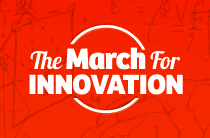Immigration laws haven't seen any major changes since 1965, so it's no wonder that it's been a hot topic lately. Recently, March for Innovation has hatched a new plan to get something done.
They'll march on Washington, without setting foot inside DC. This will be a "Virtual March," using Twitter, Facebook, and Thunderclap to push for "Innovation-focused immigration reform."
What's that? Well the March for Innovation supports providing visas to highly-skilled workers and entrepreneurs, as well as giving green cards to foreigners who graduate from U.S. universities with advanced degrees in science, technology, engineering, and mathematics (STEM). The thing is, we need them. Even if every American with an advanced STEM degree gets a job, by 2018 there will still be 200,000 left unfilled. In short, we have more STEM jobs than we have qualified people to fill them. Immigrants with advanced STEM degrees create even more jobs for Americans, and can help fill all those empty positions, according to March for Innovation's fact page.
The March is backed by several leaders in the field, including New York Mayor Michael Bloomberg, Andres Barreto (founder of Grooveshark), David Karp (founder and CEO of Tumblr), and Craig Newmark (founder of Craigslist). The Partnership for a New American Economy, a bipartisan interest group of mayors and business leaders committed to sensible immigration reform, is the organizer.
Will it work? Well, the official @MarchforInnov has just over 650 followers on Twitter, which doesn't bode very well. But the designated hashtag, #iMarch, is seeing decent action. The real test will come via Thunderclap, a platform that only sends out messages once a designated number of people have clicked the share and tweet buttons. The March's official Thunderclap page is here. They've given themselves until April 18 to generate 1,000 messages, and they're about 25 percent there.
1,000 messages doesn't sound like that many. Heck, 1,000 people showing up at a protest wouldn't even make the news in Washington. But those messages would reach 3.4 million people. With a digital protest, it's a whole new set of rules.
